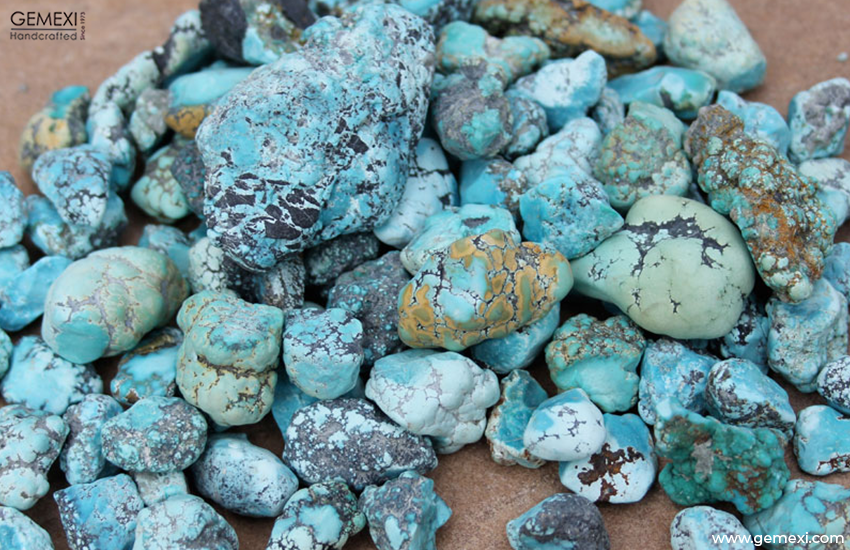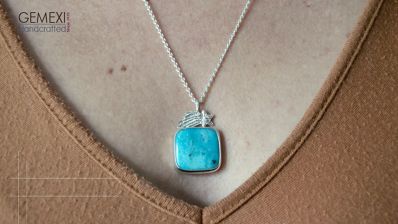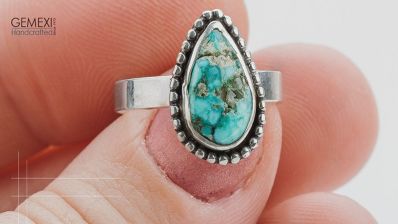How is Turquoise Stabilized?
By Gemexi Team | Turquoise- Updated On Jun 14, 2023

Turquoise is a beautiful and highly valued gemstone that has been cherished for thousands of years. Its stunning blue-green color and unique veining patterns have made it a popular choice for jewelry, art, and home decor. Turquoise is a hydrous phosphate mineral that is formed when water reacts with copper and aluminium in the earth's crust. The stone can be found in many parts of the world, including the southwestern United States, Iran, China, and Mexico.
Turquoise has played an important role in the cultural and spiritual practices of many civilizations throughout history. It was highly prized by the ancient Egyptians, who used it to adorn their jewelry and amulets. Native American tribes, such as the Navajo and Zuni, have also incorporated turquoise into their traditional art and jewelry for centuries. In many cultures, turquoise is believed to have healing properties and is thought to bring good fortune and protection to its wearer.
However, due to its softness and susceptibility to damage, turquoise can be difficult to work with and requires special care and attention. In order to enhance its durability and color, turquoise is often stabilized using a variety of techniques and methods. This can involve treating the stone with resins, dyes, or other substances to fill in cracks and enhance its natural color.
Despite its widespread popularity and cultural significance, turquoise faces several challenges in today's market. The demand for high-quality stones has led to concerns about sustainability and the ethical sourcing of turquoise. Additionally, the proliferation of synthetic and imitation stones has made it increasingly difficult to determine the authenticity and value of turquoise.
In this blog, we will explore the value of turquoise, various techniques used to stabilize turquoise and how to tell if the turquoise is real. We hope that this compact guide will help you preserve and retain the beauty and value of your favorite gemstone – Turquoise!
Turquoise has played an important role in the cultural and spiritual practices of many civilizations throughout history. It was highly prized by the ancient Egyptians, who used it to adorn their jewelry and amulets. Native American tribes, such as the Navajo and Zuni, have also incorporated turquoise into their traditional art and jewelry for centuries. In many cultures, turquoise is believed to have healing properties and is thought to bring good fortune and protection to its wearer.
However, due to its softness and susceptibility to damage, turquoise can be difficult to work with and requires special care and attention. In order to enhance its durability and color, turquoise is often stabilized using a variety of techniques and methods. This can involve treating the stone with resins, dyes, or other substances to fill in cracks and enhance its natural color.
Despite its widespread popularity and cultural significance, turquoise faces several challenges in today's market. The demand for high-quality stones has led to concerns about sustainability and the ethical sourcing of turquoise. Additionally, the proliferation of synthetic and imitation stones has made it increasingly difficult to determine the authenticity and value of turquoise.
In this blog, we will explore the value of turquoise, various techniques used to stabilize turquoise and how to tell if the turquoise is real. We hope that this compact guide will help you preserve and retain the beauty and value of your favorite gemstone – Turquoise!
How to Tell If Turquoise Is Real?
-
Check the Color
Natural turquoise comes in a range of colors, from sky blue to green. However, most natural turquoise has a blue-green color with a slight variation in tone. If the color of the turquoise is too uniform or has an artificial look to it, it may be a sign that the turquoise is fake. Also, if the color of the turquoise rubs off or fades, it is a sign that it may not be genuine.
-
Look for Imperfections
Natural turquoise is formed by a slow and complex process that involves the interaction of minerals and water. As a result, natural turquoise often has imperfections such as small cracks, pits, or areas of discoloration. These imperfections are a sign that the turquoise is genuine. In contrast, fake turquoise is typically made from plastic, resin, or other synthetic materials that are uniform in texture and color.
-
Conduct a Touch Test
Real turquoise has a slightly waxy or greasy feel to the touch. If you rub the surface of the turquoise gently, it should feel slightly oily. This is because natural turquoise contains small amounts of natural oils that give it its characteristic texture. In contrast, fake turquoise feels smooth, and hard, and may have a plastic-like texture.
-
Check for Hardness
Turquoise has a relatively low hardness level, which means that it can be scratched or damaged by harder materials. You can conduct a simple hardness test by lightly scratching the surface of the turquoise with a steel nail or a piece of glass. If the surface of the stone is scratched or damaged, it is a sign that the turquoise may be genuine. However, if the stone remains intact and undamaged, it may be a sign that the turquoise is fake.
-
Seek Professional Assistance
If you are still unsure whether your turquoise is genuine or fake, you can seek professional assistance. A gemologist or a jewelry appraiser can examine the turquoise and determine if it is genuine or not. They can also provide you with a certificate of authenticity, which can give you peace of mind and help you resell the turquoise later.
In conclusion, these tips can help you determine if your turquoise is genuine or fake. However, the best way to ensure that your turquoise is real is to buy it from a reputable dealer or have it authenticated by a professional gemologist.
In conclusion, these tips can help you determine if your turquoise is genuine or fake. However, the best way to ensure that your turquoise is real is to buy it from a reputable dealer or have it authenticated by a professional gemologist.
How To Determine the Value of Turquoise (What Is It Worth?)
-
Quality of the Stone
The quality of the turquoise stone is one of the most important factors that determine its value. High-quality turquoise has a deep, even color and a distinctive pattern. The stone should be free of cracks, pits, or other imperfections that can affect its appearance or stability. The size and shape of the stone can also impact its value, with larger, well-formed stones being more valuable.
-
Origin of the Stone
The origin of the turquoise can also affect its value. Turquoise from certain locations such as Iran, Egypt, and the southwestern United States, including Arizona and New Mexico, is considered to be of higher quality and more valuable. The rarity of the turquoise from a particular location can also impact its value.
-
The rarity of the Stone
The rarity of the turquoise can also affect its value. Some types of turquoise, such as Sleeping Beauty turquoise from Arizona, are becoming increasingly rare due to limited mining activity. Turquoise that is difficult to find or has limited availability can be more valuable.
-
Treatment or Enhancement
Turquoise can be treated or enhanced to improve its color or stability. The most common treatments include stabilization, dyeing, or coating. However, treated turquoise is generally less valuable than untreated turquoise, as it may not be considered natural or authentic. If a stone has been treated, it is essential to disclose this information when selling or buying it.
-
Market Demand
The market demand for turquoise can also affect its value. Turquoise is a popular gemstone that is widely used in jewelry and decorative objects. However, the market demand for turquoise can fluctuate depending on factors such as fashion trends, the economy, and cultural influences.
In conclusion, determining the value of turquoise can be a complex process that involves several factors. The quality of the stone, its origin, rarity, treatment or enhancement, and market demand can all impact its value. If you are interested in buying or selling turquoise, it is essential to work with a reputable dealer or appraiser who can help you determine its value and ensure a fair price.
In conclusion, determining the value of turquoise can be a complex process that involves several factors. The quality of the stone, its origin, rarity, treatment or enhancement, and market demand can all impact its value. If you are interested in buying or selling turquoise, it is essential to work with a reputable dealer or appraiser who can help you determine its value and ensure a fair price.
Difference between Natural and Stabilized Turquoise
-
Natural Turquoise:
Natural turquoise is formed over millions of years through a complex process that involves the interaction of copper, aluminium, and other minerals with water and oxygen. The resulting mineral deposits are often found in veins or nodules within host rocks, such as sandstone or shale. Natural turquoise can vary in color, from light blue to green, and can have unique patterns and markings that make each stone one-of-a-kind.
One of the challenges of natural turquoise is its fragility. It can be prone to cracking or changing color over time due to exposure to heat, light, or chemicals. Natural turquoise is also susceptible to damage from physical impact or scratching.
One of the challenges of natural turquoise is its fragility. It can be prone to cracking or changing color over time due to exposure to heat, light, or chemicals. Natural turquoise is also susceptible to damage from physical impact or scratching.
-
Stabilized Turquoise:
Stabilized turquoise is natural turquoise that has been treated with a stabilizing agent to enhance its durability and color. The stabilizing agent is typically a clear epoxy resin or polymer that fills the pores of the stone and hardens to create a more durable surface. This process can also enhance the color of the turquoise by filling in any cracks or voids that may have altered its appearance. Once the resin has fully cured, the stabilized turquoise can be sanded, polished, and shaped to create jewelry and other decorative items.
One of the benefits of stabilized turquoise is its increased durability. The stabilizing agent can make the turquoise less prone to cracking or changing color over time, making it more suitable for use in jewelry and decorative arts. Stabilized turquoise is also more resistant to physical impact or scratching than natural turquoise.
However, stabilized turquoise is often criticized for its altered state. Some argue that stabilized turquoise is less valuable or rare than natural, untreated turquoise, as the treatment alters its natural state. Additionally, some stabilization methods can use harsh chemicals that can be harmful to the environment or to those who handle the turquoise.
One of the benefits of stabilized turquoise is its increased durability. The stabilizing agent can make the turquoise less prone to cracking or changing color over time, making it more suitable for use in jewelry and decorative arts. Stabilized turquoise is also more resistant to physical impact or scratching than natural turquoise.
However, stabilized turquoise is often criticized for its altered state. Some argue that stabilized turquoise is less valuable or rare than natural, untreated turquoise, as the treatment alters its natural state. Additionally, some stabilization methods can use harsh chemicals that can be harmful to the environment or to those who handle the turquoise.
Choosing between Natural and Stabilized Turquoise
Choosing between natural and stabilized turquoise ultimately comes down to personal preference and intended use. If you value the uniqueness and natural beauty of turquoise, natural stones may be a better choice. However, if you plan to use turquoise in high-traffic jewelry or decorative items, stabilized turquoise may be more practical. It is important to purchase from a reputable dealer who can provide information about the origin and treatment of the gemstone to ensure that you are getting a high-quality product.
In conclusion, both natural and stabilized turquoises have their own unique characteristics and benefits. Whether you prefer natural or stabilized turquoise, it is important to consider your intended use and purchase from a reputable dealer to ensure that you are getting a high-quality product.
In conclusion, both natural and stabilized turquoises have their own unique characteristics and benefits. Whether you prefer natural or stabilized turquoise, it is important to consider your intended use and purchase from a reputable dealer to ensure that you are getting a high-quality product.
What is the process of stabilizing Turquoise?
Stabilizing turquoise is a process of treating the stone with a stabilizing agent to enhance its durability and appearance. The process involves several steps that are detailed below:
-
Selecting the Turquoise
The first step in stabilizing turquoise is selecting the appropriate stones. Not all types of turquoise are suitable for stabilization. Typically, stones with cracks, voids, or porosity are chosen for stabilization. The turquoise should be clean and free of any oils or debris that can affect the stabilization process.
-
Cleaning the Turquoise
The selected turquoise is thoroughly cleaned using a mild soap and water solution. This removes any dirt, oils, or other impurities from the surface of the stone that could interfere with the stabilization process.
-
Drying the Turquoise
Once cleaned, the turquoise is dried completely. Any residual moisture can negatively impact the stabilization process, so it is important to ensure the stone is completely dry.
-
Filling the Porosity
Before the stabilization process can begin, any cracks, voids, or porosity in the turquoise must be filled. This is done using filler material, such as epoxy resin or polymer. The filler is applied to the surface of the stone and allowed to seep into the pores. The excess filler is then wiped off, and the stone is allowed to dry.
-
Vacuum Impregnation
After the porosity is filled, the turquoise is ready for the stabilization process. Vacuum impregnation is one of the most common methods used to stabilize turquoise. In this method, the stabilized agent is introduced into the stone under a vacuum. The vacuum creates a low-pressure environment that allows the stabilizing agent to penetrate the surface of the stone and fill any remaining pores or cracks.
-
Heating the Turquoise
After the turquoise has been vacuum impregnated, it is heated to cure the stabilizing agent. The heat helps to harden the stabilizing agent and create a more durable surface. The temperature and duration of the heating process will depend on the type of stabilizing agent used and the size and thickness of the turquoise.
-
Cooling the Turquoise
Once heated, the turquoise is allowed to cool slowly to room temperature. Rapid cooling can cause the stone to crack or change color, so it is important to let the stone cool slowly.
-
Shaping and Polishing
After the turquoise has cooled, it can be shaped and polished to create the desired finished product. This can be done using a variety of tools and techniques, such as sanding, cutting, and polishing.
-
Inspection and Grading
The final step in the stabilization process is to inspect and grade the stabilized turquoise. The stone is examined for any defects, such as cracks or uneven coloring. The stone is then graded based on its quality and appearance.
In conclusion, stabilizing turquoise is a process that involves filling the porosity of the stone, introducing a stabilizing agent, and curing the stone through heating. While there are several different methods for stabilizing turquoise, vacuum impregnation is one of the most common. The stabilized turquoise can then be shaped and polished to create a variety of jewelry and decorative items. Stabilized turquoise is a more durable alternative to natural turquoise and can offer unique color variations and patterns.
In conclusion, stabilizing turquoise is a process that involves filling the porosity of the stone, introducing a stabilizing agent, and curing the stone through heating. While there are several different methods for stabilizing turquoise, vacuum impregnation is one of the most common. The stabilized turquoise can then be shaped and polished to create a variety of jewelry and decorative items. Stabilized turquoise is a more durable alternative to natural turquoise and can offer unique color variations and patterns.
- Tags:
- Value Of Turquoise
- Turquoise Stabilized
- Difference Between Natural And Stabilized Turquoise
- How To Tell If Turquoise Is Real










0 Comments
Write Comments